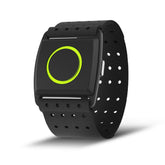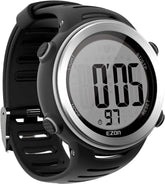Beginner's 10K Training Plan with GPS and Heart Rate Tracking
Embrace the challenge of completing your first 10K with a science-backed training plan that combines GPS running watch precision and heart rate monitor insights. This 8-week program prioritizes gradual progression, injury prevention, and data-driven adjustments—perfect for beginners ready to turn fitness goals into finish-line triumphs.
1. Pre-Training Prep: Laying the Foundation
A. Gear Essentials for Success
- GPS Running Watch:
- Critical for mapping progress and ensuring workout intensity aligns with goals.
- Heart Rate Monitor:
- Helps avoid overtraining by keeping you within optimal heart rate zones.
B. Fitness Baseline: Set Your Starting Point
- 1-Mile Time Trial:
- Jog 1 mile at a comfortable pace to establish a baseline fitness level.
- Record time and resting heart rate (RHR) to measure improvements.
- Heart Rate Zone Calculation:
- Estimate max heart rate (MHR) = 220 - age, then define zones:
- Zone 2 (Easy Run): 60–70% MHR (builds aerobic endurance)
- Zone 3 (Tempo Run): 70–80% MHR (improves lactate threshold)
2. 8-Week Beginner 10K Training Plan
A. Weekly Structure: Balance Training & Recovery
|
Week
|
Focus
|
Weekly Mileage
|
Heart Rate Target
|
Key Workouts
|
|
1–2
|
Walk-Run Intervals
|
6–8 miles
|
60–65% MHR
|
30 mins: 1 min run + 2 min walk x 10
|
|
3–4
|
Steady Pace Endurance
|
8–10 miles
|
65–70% MHR
|
40 mins: continuous easy run
|
|
5–6
|
Tempo Intervals
|
10–12 miles
|
70–75% MHR
|
4x8 mins run @ Zone 3 + 2 mins rest
|
|
7–8
|
Race Simulation
|
12–15 miles
|
70–80% MHR
|
10K distance at goal race pace
|
B. Daily Routine with Tech Integration
- Warm-Up (10 mins):
- Light jog or dynamic stretches, monitored via GPS watch to ensure slow heart rate increase.
- Main Workout:
- Use watch GPS to track route and pace, heart rate monitor to stay within target zones.
- Cool-Down (5 mins):
- Walk while reviewing post-workout data: average pace, max heart rate, and calorie burn.
3. Maximizing Tech: GPS & Heart Rate Tools in Action
A. GPS Running Watch Features for Beginners
- Route Planning:
- Pre-load flat, beginner-friendly routes with apps like Strava or MapMyRun, synced to your watch.
- Pace Alerts:
- Set vibrations for off-pace warnings (e.g., "Slow down—you’re exceeding Zone 2").
- Distance Tracking:
- Auto-pause at stoplights and accurate lap splits for interval workouts.
B. Heart Rate Monitor Insights
- Effort Calibration:
- Ensure easy runs feel "conversational" (can speak in full sentences, 60–70% MHR).
- Recovery Checks:
- Post-run, check how quickly heart rate drops—1 min recovery to <90 BPM indicates good fitness.
- Overtraining Prevention:
- If morning RHR increases by 5–10 BPM, take a rest day (monitored via heart rate monitor).
4. Nutrition & Recovery: Fueling the Journey
A. Pre-Run Fueling Strategy
- 1–2 Hours Before:
- 30–50g complex carbs (e.g., oatmeal with banana) to boost glycogen stores.
- 15 Minutes Before:
- 10–15g simple carbs (e.g., energy gel or honey) for quick energy, guided by watch reminders.
B. Post-Run Recovery Protocol
- 30-Minute Window:
- 20g protein + 40g carbs (e.g., chocolate milk + rice cakes) to aid muscle repair.
- Active Recovery Days:
- Light cross-training (cycling/swimming) at <60% MHR, tracked via heart rate monitor.
C. Hydration & Sleep Essentials
- Hydration Alerts:
- Program your GPS watch to remind water intake (200ml every 30 mins during runs).
- Sleep Tracking:
- Aim for 7–9 hours/night—use watch data to correlate poor sleep with elevated resting heart rate.
5. Common Beginner Mistakes & Solutions
A. Mistake 1: Increasing Mileage Too Quickly
- Solution:
- Adhere to the "10% rule"—never increase weekly mileage by more than 10%.
- Use GPS watch to track cumulative weekly distance and set alerts for overload.
B. Mistake 2: Ignoring Heart Rate Signals
- Solution:
- If heart rate spikes 5% above target zone for 10+ mins, slow to a walk until it recovers.
- Review post-workout heart rate graphs to identify fatigue patterns.
C. Mistake 3: Skipping Strength Training
- Solution:
- Add 2x/week strength sessions (squats, planks) to build running-specific muscles.
- Use heart rate monitor to ensure strength work stays in recovery zone (<60% MHR).
6. FAQs: Your 10K Training Questions Answered
Q: How many days a week should I train?
- 3–4 days/week: 2–3 runs + 1 cross-training day. Rest days are crucial for injury prevention.
Q: Can I use a basic fitness tracker instead of a GPS watch?
Q: What's the ideal pace for a beginner 10K?
- Start with 10–12 min/mile (6–7.5 min/km). Focus on maintaining a sustainable heart rate zone over speed.
Q: How to stay motivated throughout the plan?
- Set small milestones (e.g., "Complete Week 4 without missing a workout") and celebrate with non-food rewards.
Cross the Finish Line with Confidence
This 10k training plan for beginners combines the structure of a progressive workout schedule with the precision of GPS running watch and heart rate monitor technology. By letting data guide your effort, you’ll build fitness safely, avoid burnout, and develop a sustainable running routine.
Remember, the goal is progress, not perfection. Lace up your shoes, sync your devices, and trust the plan—every mile logged is a step closer to conquering your first 10K. The finish line is waiting—now go make it yours.
EZON: Gear Up for Your 10K Journey









